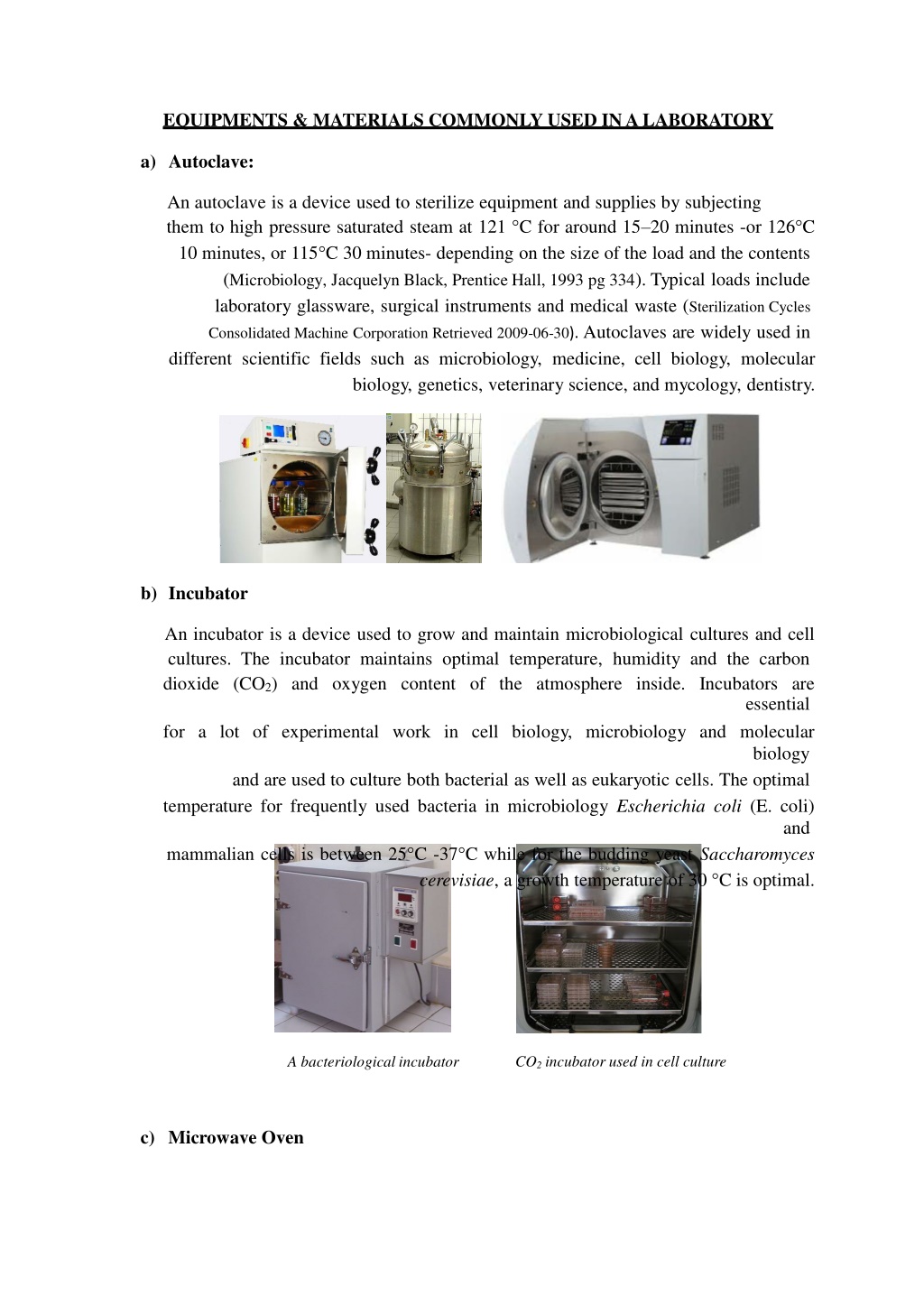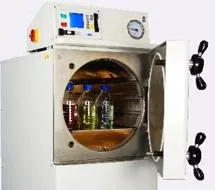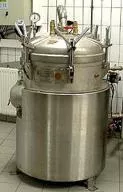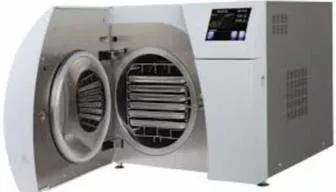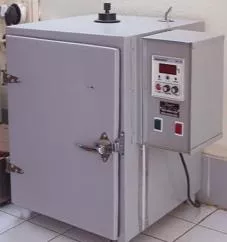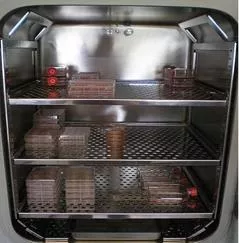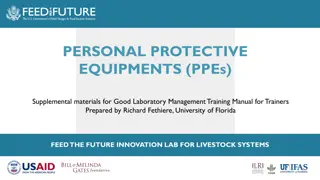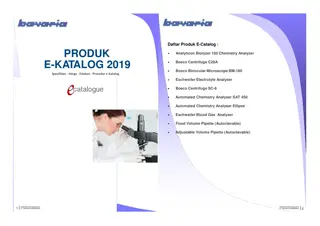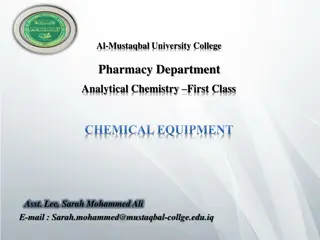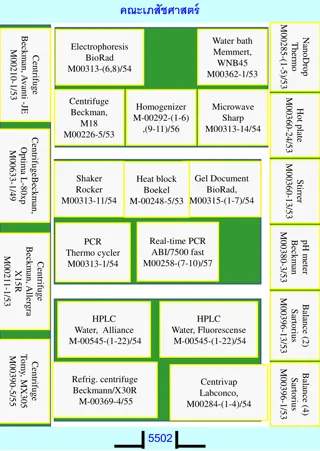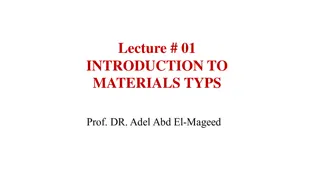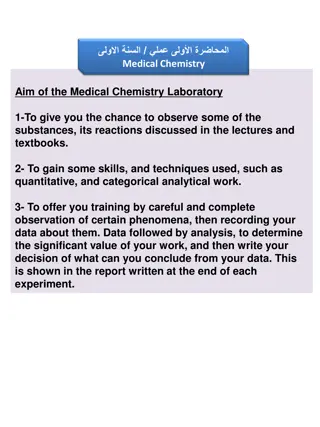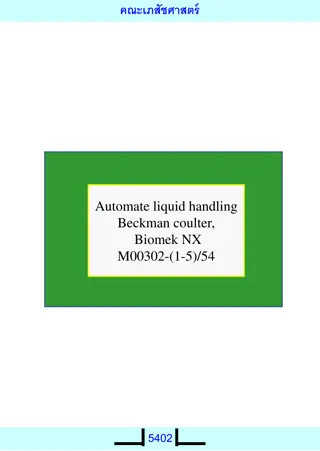Essential Laboratory Equipment and Materials
Autoclaves, incubators, microwaves, vacuum furnaces, freezers, centrifuges, spectrophotometers, and analytical balances are commonly used in laboratories for sterilization, culture growth, sample preparation, drying, storage, precipitation, spectrophotometry, and precise weight measurements. These equipment play vital roles in various scientific fields such as microbiology, molecular biology, genetics, and more.
Download Presentation

Please find below an Image/Link to download the presentation.
The content on the website is provided AS IS for your information and personal use only. It may not be sold, licensed, or shared on other websites without obtaining consent from the author.If you encounter any issues during the download, it is possible that the publisher has removed the file from their server.
You are allowed to download the files provided on this website for personal or commercial use, subject to the condition that they are used lawfully. All files are the property of their respective owners.
The content on the website is provided AS IS for your information and personal use only. It may not be sold, licensed, or shared on other websites without obtaining consent from the author.
E N D
Presentation Transcript
EQUIPMENTS & MATERIALS COMMONLY USED INA LABORATORY a) Autoclave: An autoclave is a device used to sterilize equipment and supplies by subjecting them to high pressure saturated steam at 121 C for around 15 20 minutes -or 126 C 10 minutes, or 115 C 30 minutes- depending on the size of the load and the contents (Microbiology, Jacquelyn Black, Prentice Hall, 1993 pg 334). Typical loads include laboratory glassware, surgical instruments and medical waste (Sterilization Cycles Consolidated Machine Corporation Retrieved 2009-06-30). Autoclaves are widely used in different scientific fields such as microbiology, medicine, cell biology, molecular biology, genetics, veterinary science, and mycology, dentistry. b) Incubator An incubator is a device used to grow and maintain microbiological cultures and cell cultures. The incubator maintains optimal temperature, humidity and the carbon dioxide (CO2) and oxygen content of the atmosphere inside. Incubators are essential for a lot of experimental work in cell biology, microbiology and molecular biology and are used to culture both bacterial as well as eukaryotic cells. The optimal temperature for frequently used bacteria in microbiology Escherichia coli (E. coli) and mammalian cells is between 25 C -37 C while for the budding yeast Saccharomyces cerevisiae, a growth temperature of 30 C is optimal. CO2incubator used in cell culture A bacteriological incubator c) Microwave Oven
Microwave is generally used to prepare agarose gel mostly used in the area of molecular biology and to melt medium in microbiology laboratories. d) Vacuum Furnace Vacuum furnace is a machine that allows drying of heat sensitive materials using reduced pressure at low temperatures. It is also used to water in aqueous samples by the vacuum. e) Freezer Freezer is a device used to storage the samples; human blood, cell culture, DNA, RNA samples, at -20 C, -40 C or -80 C for long periods. -20 C Freezer -40 C Freezer -80 C Freezer f) Centrifuge Centrifuges are commonly used in order to collect the desired part of the mixture by precipitation as a phased. There are variable types of centrifuges as commercially available: Ultracentrifuges, Hematocrit centrifuges, Gas centrifuges, Cooled or uncooled centrifuges. The units of revolutions per minute; rpm or gravitational acceleration; g are used to calculate for a rotation speed of centrifuges.
Ultracentrifuges are used to precipitate the cell organelles, such as mitochondria at 100000g and higher speed of 100000g. g) Spectrophotometer Spectrophotometry is the quantitative measurement of the transmission properties of a material as a function of wavelength. Visible light is measured in glass tub while ultraviolet light in quartz tub. They are widely used in many industries including semiconductors, laser and optical manufacturing, printing and forensic examination, and as well in laboratories for the study of chemical substances. Ultimately, a spectrophotometer is able to determine, depending on the control or calibration, what substances are present in a target and exactly how much through calculations of observed wavelength. h) Analytical Balance It is an instrument capable of making precise measurements of weight of objects of relatively small mass: of the order of a thousand parts of a gram; milligram,mg. As with other laboratory machines and equipment, balancers must be set up and controlled in certain intervals.
i) Water Bath There are two types of water baths, digital and analog, both of them can be heated up to 100 degree centigrade. j) Shaker Bath Shaker bath is used to mix various solutions and the speed and temperature of machine can be adjusted. k) Distilled Water Device This machine is used, to produce pure water, for the removal of impurities from tap water. l) Electrophoresis Device Polyacrylamide and agarose gel electrophoresis are applied for the separation and characterization of proteins, nucleic acids (deoxyribonucleic acid; DNA and ribonucleic acid; RNA). The principle of this method is that the charged particles of a sample such as DNAmigrate in an applied electrical field. For instance, DNAis a negatively charged molecules and gel electrophoresis is positively charged therefore, DNAfragments easily migrate to the positive side of the acrylamide gel.
m) Laminar Flow The device allows working with drug, culture, chemical and microorganisms in a sterile environment. A laminar flow cabinet or bio safety cabinet or tissue culture hood is a carefully enclosed bench designed to prevent contamination of semiconductor wafers, biological samples, or any particle sensitive device. Air is drawn through a HEPA filter and blown in a very smooth, laminar flow towards the user. The cabinet is usually made of stainless steel with no gaps or joints where spores might collect. n) Vortex Vortex is commonly used to provide a homogeneous mixing of the test tube contents. o) Magnetic Stirrer or Mixer and Magnetic Heater A magnetic stirrer or magnetic mixer employs a rotating magnetic field to cause a stir bar immersed in a liquid to spin very quickly, thus stirring it. The rotating field may be created either by a rotating magnet or a set of stationary electromagnets, placed beneath the vessel with the liquid. The temperature of mixer can be adjusted. Vortex Magnetic Stirrer
p) Tubes There are four types of tubes used in the different scientific fields; microbiology, molecular biology, genetics and immunology. Test tubes; is a common piece of laboratory glassware consisting of clear plastic tubing, open at the top, with a rounded U-shaped bottom. Eppendorf tubes; are 1.5 mL or 2mL micro test tubes connected with a plastic cover on top used in mostly biotechnology laboratories. Durham tubes; are used to detect whether there is a production of gas by microorganisms. Centrifuge tubes; are made of glass or plastic used extensively in molecular biology laboratories. The most commonly encountered tubes are of about the size and shape of a normal test tube. Also, the bottom portion of tubes is narrow and specific for only centrifuges machines. q) Test Tube Holder Tube holders are made of plastic, wooden or metal materials in which are different diameters holes and used to put the tubes appropriately. r) Petri Dish (Agar Plate) Petri Dishes are shallow lidded dish and the main laboratory equipment mostly used in microbiology. Glass petri dishes can be reused by sterilization whilst plastic petri dishes often used as disposables in order to eliminate contamination. http://en.wikipedia.org/wiki/Agar_plate
s) Inoculation Loop An inoculation loop is used to transfer bacteria for microbiological culture. http://en.wikipedia.org/wiki/Inoculation_loop t) Pipettes There are two different types of Micropipettes; single-channel and multichannel, which are the most used laboratory equipment and both of the types are operated by piston-air displacement. These pipettes are required disposable tips that come in contact with the fluid. There are four standardized single-channel pipettes, commercially available, measured volume between 0.1 l to 1000 l (1ml) (see Table 1). Table 1: Four different Single- channel pipettes Volumes ( L) Pipette type 0.5 10 2 20 P10 P20 P200 20 200 P1000 200 1000 A manual propipetter, is adjusted by squeezing the bulb and used to pull toxic and dangerous liquids by bulb. Drain-out pipettes help to pull the needed volume into the pipette and can be aliquoted out if the pulled volume is more than needed. !!! Please do not drop pipettes on the ground!!!
u) Glass slide and cover slips Glass slides and cover slips are used to hold biological samples, in natural forms or after staining, for examination under the microscope. Cover slip is smaller and thinner than glass slide and always used together which allows the samples easily inserted and removed from the microscope transported and stored in slide cases. v) Erlenmeyer: Erlenmeyer flasks are heat-resistant and extremely useful in the lab setting for stirring the contents by hand by swirling the flask because of its flat bottom, conical body and cylindrical neck. -Beaker is a container for stirring, mixing and heating liquids; is generally cylindrical in shape, with a flat bottom. -Volumetric flasks are made of plastic or glass materials, ranging from 10ml to 1000ml that are used for precise dilutions and preparation of standard solutions in mostly chemistry laboratories. -Round bottom flasks, are usually used to dilute solutions and liquids mostly in chemistry and molecular biology laboratories. -Mortar, is a bowl, made of wood or ceramic. The substance is placed on the ground of mortar and crushed or mixed with the pestle; mostly used in pharmacies. -Dry ice is the solid form of carbon dioxide. It is not very toxic and much cooler than water ice thus usually uses as a cooling agent in the laboratory.
